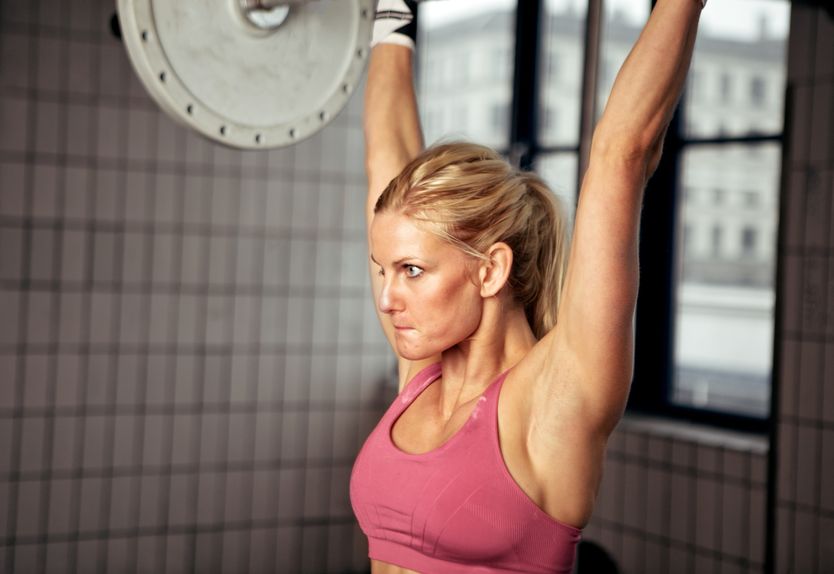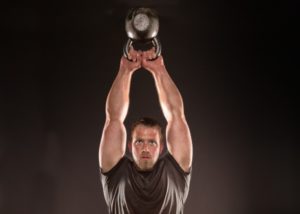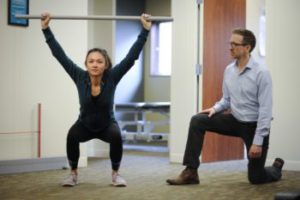CrossFit Injuries: Shoulder Pain

Shoulder Pain in CrossFit
The shoulder is a complicated structure. As highlighted in the CrossFit Journal Article “The Optimal Shoulder,” over 80% of CrossFit workouts involve a shoulder movement. If you are a CrossFit athlete, your shoulders better be functioning optimally if you want to perform at your best and stay healthy! Here are some tips for avoiding injuries causing shoulder pain, such as shoulder impingement.
 Symptoms
Symptoms
Most often when we see a CrossFit injury involving shoulder pain, the cause is poor movement. Shoulder health and performance are reliant on multiple factors, including:
- The rotator cuff’s ability to stabilize the shoulder
- Muscle balance between the anterior and posterior shoulder muscles
- The scapula (shoulder blade) properly rotating during shoulder movements
- Thoracic spine mobility
- Shoulder (glenohumeral) mobility
When any one of these is not functioning correctly, it causes poor movement leading to shoulder pain and injury. The most common movement issue we see is referred to as upper cross syndrome. This occurs when the pec muscles are short and tight, the upper traps are over-active, and the rotator cuff does not stabilize the shoulder properly. This typically leads to shoulder pain and impingement because the shoulder will not move properly with overhead lifts and movements such as handstand push-ups, snatch, pull-ups, push press, etc.
With shoulder impingement, the soft tissues of the shoulder at pinched between the humeral head and acromion process. This results in pain in the front and top of the shoulder, muscle weakness, decreased mobility and ultimately, poor performance. If allowed to continue without treatment, this can progress to more serious problems including a rotator cuff tear.
Prevention & Self Treatment
Stretching and lacrosse ball rolling the pec and upper trap muscles will help ensure that the front of the shoulder isn’t being over-stressed during repetitive exercise like CrossFit WODs. Proper technique and isolated rotator cuff strengthening exercises will decrease the risk of upper cross syndrome affecting shoulder performance. Proper cool down and recovery after workouts also plays an important role in avoiding any shoulder-related sports injury. Occasional maintenance visits to your sports chiropractor to make sure your thoracic spine and shoulder joints are moving well and muscles are functioning properly is a great way to catch minor issues early and prevent potential injuries from occurring. Kinesio-taping for workouts can also be beneficial, just make sure you follow an appropriate set of instructions. Here’s a good starting point, RockTape applications for the shoulder and upper back.
You can also find most of our preferred rotator cuff exercises on our YouTube channel, with new content being added all the time.
Sports Chiropractic Treatment
Be smart! If you are not getting better, get some help. I cannot tell you how many patients come to us after waiting months or even years before seeking treatment. The longer you wait, the harder it is to correct the issue!
Our Approach
 On your first chiropractic visit, we are going to watch and analyze the way you perform common shoulder movements and exercises. Several orthopedic tests will also be performed to evaluate for the need any diagnostic imaging. Once your diagnosis and the cause of your injury has been identified, we can start a targeted sports chiropractic treatment plan. Our treatments include soft tissue treatments (such as Graston Technique or myofascial release), specific corrective exercises, and possibly joint manipulations. This WILL require homework from you! We encourage a team approach to treatment at Elite. We are not here just to fix you, we want to educate you on why this injury occurred and give you the information you need to keep it from happening again!
On your first chiropractic visit, we are going to watch and analyze the way you perform common shoulder movements and exercises. Several orthopedic tests will also be performed to evaluate for the need any diagnostic imaging. Once your diagnosis and the cause of your injury has been identified, we can start a targeted sports chiropractic treatment plan. Our treatments include soft tissue treatments (such as Graston Technique or myofascial release), specific corrective exercises, and possibly joint manipulations. This WILL require homework from you! We encourage a team approach to treatment at Elite. We are not here just to fix you, we want to educate you on why this injury occurred and give you the information you need to keep it from happening again!
This article is part of a series looking at common CrossFit and lifting injuries, how to prevent them, and how to treat them if they do occur. We cover the following injuries:
- Low Back Pain/Sciatica
- Knee Pain
- Shoulder Pain (Impingement)
- Elbow Pain (Tendinitis)
- Neck Pain
 262-373-9168
262-373-9168



